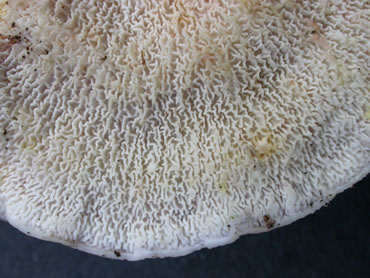Byssomerulius incarnatus
Scientific name: Byssomerulius incarnatus (Schwein.)
Gilb.
Derivation of name:
incarnatus means "flesh-colored."
Synonymy: Phlebia incarnata (Schwein.)
Nakasone & Burds.; Merulius incarnatus Schweinitz
Common names: Coral-pink Merulius.
Phylum: Basidiomycota
Order: Polyporales
Family: Meruliaceae
Occurrence on wood substrate: Saprobic; forming
overlapping clusters on dead deciduous wood;
September through October.
Dimensions: Caps 3-10 cm wide and 2-4 cm long.
Upper surface: Coral pink when fresh, fading to
pinkish-white; finely hairy.
Pore surface: Pore-like with netlike folds or
shallow
elongate pores, branching and cross-veined; whitish to
orange-white to pinkish-orange.
Comments: The network of radiating and cross-veined
folds and ridges on the fertile surface of Phlebia species
is not a true tube layer as in the true polypores. Basidia
cover just the lining of the tubes in the true polypores but
basidia cover the entire surface of the pore-like layer in
Phlebia species.
More information at MushroomExpert.com:

Figure 1. Byssomerulius incarnatus on wood.
Photo © John Plischke III.

Figure 2. The finely hairy, coral-pink upper surface of
Byssomerulius incarnatus.
Photo © Dorothy Smullen.

Figure 3. Specimens brought in during a foray.
Photo © Dorothy Smullen.

Figure 4. The pore-like surface of Byssomerulius
incarnatus
is quite unusual.
Photo © TomVolk.

Figure 5. Instead of pores there is a network
of branching and cross-veined ridges.
Photo © Tom Volk.

Figure 6. The ridges are narrower than those in Figure 5 but
similar in basic appearance. Photo © Gary Emberger.